Amino acid sequence requirements of the transmembrane and cytoplasmic domains of influenza virus hemagglutinin for viable membrane fusion
- PMID: 10359599
- PMCID: PMC25377
- DOI: 10.1091/mbc.10.6.1821
Amino acid sequence requirements of the transmembrane and cytoplasmic domains of influenza virus hemagglutinin for viable membrane fusion
Abstract
The amino acid sequence requirements of the transmembrane (TM) domain and cytoplasmic tail (CT) of the hemagglutinin (HA) of influenza virus in membrane fusion have been investigated. Fusion properties of wild-type HA were compared with those of chimeras consisting of the ectodomain of HA and the TM domain and/or CT of polyimmunoglobulin receptor, a nonviral integral membrane protein. The presence of a CT was not required for fusion. But when a TM domain and CT were present, fusion activity was greater when they were derived from the same protein than derived from different proteins. In fact, the chimera with a TM domain of HA and truncated CT of polyimmunoglobulin receptor did not support full fusion, indicating that the two regions are not functionally independent. Despite the fact that there is wide latitude in the sequence of the TM domain that supports fusion, a point mutation of a semiconserved residue within the TM domain of HA inhibited fusion. The ability of a foreign TM domain to support fusion contradicts the hypothesis that a pore is composed solely of fusion proteins and supports the theory that the TM domain creates fusion pores after a stage of hemifusion has been achieved.
Figures

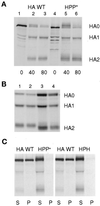
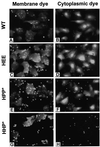
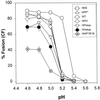

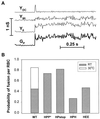


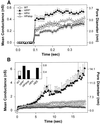
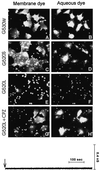

Similar articles
-
Modification of the cytoplasmic domain of influenza virus hemagglutinin affects enlargement of the fusion pore.J Virol. 2000 Aug;74(16):7529-37. doi: 10.1128/jvi.74.16.7529-7537.2000. J Virol. 2000. PMID: 10906206 Free PMC article.
-
The transmembrane domain of influenza hemagglutinin exhibits a stringent length requirement to support the hemifusion to fusion transition.J Cell Biol. 2000 Oct 16;151(2):425-37. doi: 10.1083/jcb.151.2.425. J Cell Biol. 2000. PMID: 11038188 Free PMC article.
-
Fusion activity of transmembrane and cytoplasmic domain chimeras of the influenza virus glycoprotein hemagglutinin.J Virol. 1998 Jan;72(1):133-41. doi: 10.1128/JVI.72.1.133-141.1998. J Virol. 1998. PMID: 9420208 Free PMC article.
-
Structural and functional specificity of Influenza virus haemagglutinin and paramyxovirus fusion protein anchoring peptides.Virus Res. 2017 Jan 2;227:183-199. doi: 10.1016/j.virusres.2016.09.014. Epub 2016 Oct 20. Virus Res. 2017. PMID: 27773768 Review.
-
Influenza fusion peptides.Biochem Soc Trans. 2001 Aug;29(Pt 4):623-6. doi: 10.1042/bst0290623. Biochem Soc Trans. 2001. PMID: 11498040 Review.
Cited by
-
A dual-functional paramyxovirus F protein regulatory switch segment: activation and membrane fusion.J Cell Biol. 2003 Oct 27;163(2):363-74. doi: 10.1083/jcb.200305130. J Cell Biol. 2003. PMID: 14581458 Free PMC article.
-
Role for influenza virus envelope cholesterol in virus entry and infection.J Virol. 2003 Dec;77(23):12543-51. doi: 10.1128/jvi.77.23.12543-12551.2003. J Virol. 2003. PMID: 14610177 Free PMC article.
-
Length requirements for membrane fusion of influenza virus hemagglutinin peptide linkers to transmembrane or fusion peptide domains.J Virol. 2008 Jul;82(13):6337-48. doi: 10.1128/JVI.02576-07. Epub 2008 Apr 16. J Virol. 2008. PMID: 18417593 Free PMC article.
-
Characterizing a histidine switch controlling pH-dependent conformational changes of the influenza virus hemagglutinin.Biophys J. 2013 Aug 20;105(4):993-1003. doi: 10.1016/j.bpj.2013.06.047. Biophys J. 2013. PMID: 23972851 Free PMC article.
-
Studies on influenza haemagglutinin fusion peptide mutants generated by reverse genetics.EMBO J. 2001 Aug 15;20(16):4432-42. doi: 10.1093/emboj/20.16.4432. EMBO J. 2001. PMID: 11500371 Free PMC article.
References
-
- Brown DA, London E. Structure of detergent-resistant membrane domains: does phase separation occur in biological membranes? Biochem Biophys Res Commun. 1997;240:1–7. - PubMed
-
- Bullough PA, Hughson FM, Skehel JJ, Wiley DC. Structure of influenza hemagglutinin at the pH of membrane fusion. Nature. 1994;371:37–43. - PubMed
Publication types
MeSH terms
Substances
Grants and funding
LinkOut - more resources
Full Text Sources
Other Literature Sources

